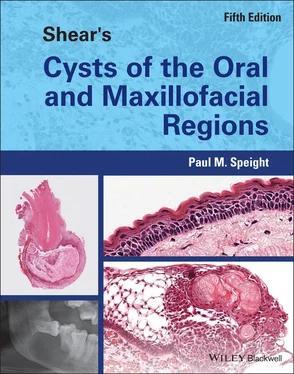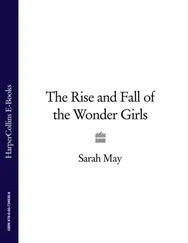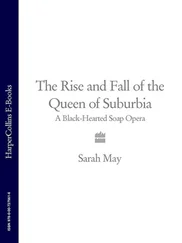Paul M. Speight - Shear's Cysts of the Oral and Maxillofacial Regions
Здесь есть возможность читать онлайн «Paul M. Speight - Shear's Cysts of the Oral and Maxillofacial Regions» — ознакомительный отрывок электронной книги совершенно бесплатно, а после прочтения отрывка купить полную версию. В некоторых случаях можно слушать аудио, скачать через торрент в формате fb2 и присутствует краткое содержание. Жанр: unrecognised, на английском языке. Описание произведения, (предисловие) а так же отзывы посетителей доступны на портале библиотеки ЛибКат.
- Название:Shear's Cysts of the Oral and Maxillofacial Regions
- Автор:
- Жанр:
- Год:неизвестен
- ISBN:нет данных
- Рейтинг книги:5 / 5. Голосов: 1
-
Избранное:Добавить в избранное
- Отзывы:
-
Ваша оценка:
- 100
- 1
- 2
- 3
- 4
- 5
Shear's Cysts of the Oral and Maxillofacial Regions: краткое содержание, описание и аннотация
Предлагаем к чтению аннотацию, описание, краткое содержание или предисловие (зависит от того, что написал сам автор книги «Shear's Cysts of the Oral and Maxillofacial Regions»). Если вы не нашли необходимую информацию о книге — напишите в комментариях, мы постараемся отыскать её.
Shear’s Cysts of the Oral and Maxillofacial Regions
Shear’s Cysts of the Oral and Maxillofacial Regions Fifth Edition
Shear's Cysts of the Oral and Maxillofacial Regions — читать онлайн ознакомительный отрывок
Ниже представлен текст книги, разбитый по страницам. Система сохранения места последней прочитанной страницы, позволяет с удобством читать онлайн бесплатно книгу «Shear's Cysts of the Oral and Maxillofacial Regions», без необходимости каждый раз заново искать на чём Вы остановились. Поставьте закладку, и сможете в любой момент перейти на страницу, на которой закончили чтение.
Интервал:
Закладка:
A number of other studies, which have included electron microscopy and X‐ray microanalysis, have also supported an epithelial origin (Allison 1974 , 1977a , 1977b ; Jensen and Erickson 1974 ; Morgan and Johnson 1974 ; Morgan and Heyden 1975 ; Rühl et al. 1989 ; Philippou et al. 1990 ). Morgan and Johnson (1974 ) also found cell debris and particulate matter and concluded that the bodies are a secretory product of odontogenic epithelium that is deposited on a hard surface in a manner analogous to the formation of dental cuticle on the unerupted portions of enamel surfaces. X‐ray microanalysis and scanning electron microscopic studies (Rühl et al. 1989 ; Philippou et al. 1990 ) also found that the bodies were associated with cell debris, suggesting that foreign material may irritate the epithelium to form a cuticle‐like substance. These findings are consistent with the observation that hyaline bodies are always associated with areas of chronic inflammation. In a rarely cited paper dating back to 1943, Bauer described the histology of the enamel cuticle associated with an unerupted third molar overlying the carious roots of the second molar (Bauer 1943 ). There was a periapical granuloma containing proliferating epithelium that was in continuity with the reduced enamel epithelium of the unerupted tooth. Within the epithelium Bauer described ‘bands, rods, rings, and spherically shaped bodies’, which were continuous with the primary enamel cuticle of the unerupted tooth and with the ‘dental cuticle’ surrounding the cementum of the decayed roots. He referred to these structures as ‘horny hyaline‐like bodies’ and his illustrations show structures identical to what we now regard as hyaline bodies. Bauer also noted that these bodies were associated with proliferating epithelial strands that were a ‘product’ of chronic inflammation. These simple, but careful, observations are consistent with the more detailed later studies described above and provide good evidence that hyaline bodies can derive from odontogenic epithelium and are similar to enamel cuticle.
Others, however, have believed that hyaline bodies are of haematogenous origin (Bouyssou and Guilhem 1965 ; Sedano and Gorlin 1968 ; El‐Labban 1979 ). Although the mechanism is not clear, these studies suggest that the bodies derive from thrombi or degenerate red blood cells within vessels that have become entrapped in the proliferating epithelial lining of the cyst. Browne and Matthews (1985 ) tested this hypothesis using immunohistochemistry to stain cysts for keratin, factor VIII‐related antigen, haemoglobin, and fibrinogen. The hyaline bodies were negative for all these antigens, but fibrinogen was detected in the cores of some circular and polycyclic forms. Browne and Matthews concluded that hyaline bodies were not keratinous in nature, nor did they arise from erythrocytes or capillary endothelium. They tentatively proposed that the presence of fibrinogen in the cores of some hyaline bodies could support the notion of a haematogenous origin.
Although we agree that the circular or polycyclic forms are sometimes of a morphology that suggests a transversely sectioned blood vessel, there are some puzzling features about their distribution if they were of vascular or haemotogenous origin. For one thing, they are often seen in epithelium overlying connective tissue devoid of any blood vessels. For another, they are very rarely found in the fibrous capsules, and we have never seen them in this situation. Third, if their pathogenesis is as described, it is most surprising that they are only found in lesions of odontogenic origin.
More recently a novel solution to the debate has been suggested. Sakamoto et al. (2012 ) proposed that hyaline bodies are of both haematogenous and epithelial origin. They carried out immunohistochemistry for anti‐hair keratin (CK40; AE13), CK17, CK19, and anti‐haemoglobin alpha chain on 10 cysts containing hyaline bodies. They found that hair keratin and haemoglobin alpha chain were specifically expressed in all the hyaline bodies, but not in adjacent epithelium. Hyaline bodies were also positive for orcein and Congo red and occasionally for Prussian blue. Sakamoto et al. suggested that dysregulated epithelial differentiation results in the formation of hair keratin, and that keratins and haemoglobin released from dead epithelial cells and red blood cells may aggregate to form hyaline bodies. They further proposed that these aggregates undergo β‐sheet conversion to form Congo red–positive amyloid, and that hyaline bodies are therefore a new and novel amyloidogenic protein. This unifying hypothesis was further developed by Sarode et al. (2016 ), who proposed that inflammation and osmotic pressure drive an inflammatory exudate and red blood cells into the epithelium. Degenerated red cells and accumulations of fibrinous exudate may then calcify and initiate production of enamel cuticle. This is an attractive hypothesis and is founded on the previous observations described, in particular that hyaline body production is analogous to secretion of cuticle onto a surface. It is also known that hair keratin may be a component of enamel (Duverger et al. 2016). Further studies of keratins and enamel proteins in these structures may allow this hypothesis to be properly tested and provide further clues to the origin of hyaline bodies.
Accumulation of Cholesterol
Deposition of cholesterol is a characteristic feature of long‐standing chronic inflammation at any site and is due to deposition and crystallisation of lipids, probably derived from degenerating cell walls. It is, for example, a prominent feature in atherosclerotic plaques, arthritis, appendicitis, and cholecystitis.
Deposits of cholesterol crystals are found in many radicular cysts, but by no means in all. The reported frequency varies from study to study and appears to be between about 10% and 45%. In one of the largest studies, Browne (1971b ) examined 402 radicular cysts and found evidence of cholesterol deposition in 43.5%. In other studies, the frequencies have been 9.4% (Lin et al. 2010 ), 28.5% (Shear 1963b ), and 30% (Trott and Esty 1972 ). However, it is likely that if entire cyst linings were examined instead of random sections, the frequency would be higher. Browne (1971b ) showed that there was a statistically significant correlation ( P < 0.01) between the presence of cholesterol and haemosiderin, and suggested that the main source of cholesterol was from disintegrating red blood cells in a form that readily crystallises in the tissues. This was confirmed by Arwill and Heyden (1973 ), who showed that the crystals may form in congested capillaries in the inflamed areas as they appear to be enveloped by endothelial cells. Trott et al. (1973 ) also found a close correlation between the occurrence of cholesterol and haemosiderin‐containing macrophages as well as free haemosiderin in the tissues. However, their regression analysis showed that only 35% of the cholesterol may be formed from this association, suggesting that accumulation of cholesterol may also derive from degenerating lymphocytes, plasma cells, and macrophages.
Cholesterol crystals are small, rectangular or rhomboid plate‐like crystals, which characteristically have one corner notched or cut off. They can be visualised in fresh smears of fluids or cyst contents, where they are strongly birefringent, producing an array of colours from red/orange to pale blue. Once the cholesterol crystals have been deposited in the tissues, they behave as foreign bodies and excite a foreign body giant cell reaction. They cannot, however, be seen in routine histological sections, because they are dissolved out of the tissues by the solvents used during processing. This leaves characteristic cholesterol clefts , surrounded by fibrous tissue and dense aggregations of multinucleate giant cells ( Figure 3.16b). In radicular cysts the cholesterol masses form in the fibrous wall and are associated with heavily inflamed granulation tissue, and are sometimes referred to as ‘cholesterol granulomas’. These masses are often extruded from the fibrous wall through the epithelial lining into the cyst lumen and appear macroscopically and microscopically as a ‘mural nodule’ ( Figure 3.16a). Once the entire mass has passed into the cavity, the epithelial breach may heal and cholesterol crystals may lie free in the cyst lumen (Shear 1963b ).
Читать дальшеИнтервал:
Закладка:
Похожие книги на «Shear's Cysts of the Oral and Maxillofacial Regions»
Представляем Вашему вниманию похожие книги на «Shear's Cysts of the Oral and Maxillofacial Regions» списком для выбора. Мы отобрали схожую по названию и смыслу литературу в надежде предоставить читателям больше вариантов отыскать новые, интересные, ещё непрочитанные произведения.
Обсуждение, отзывы о книге «Shear's Cysts of the Oral and Maxillofacial Regions» и просто собственные мнения читателей. Оставьте ваши комментарии, напишите, что Вы думаете о произведении, его смысле или главных героях. Укажите что конкретно понравилось, а что нет, и почему Вы так считаете.












